In 1962, Kyabje Dudjom Rinpoche appointed Chagdud Tulku Rinpoche as the first President to oversee the internal and external affairs of Dundul Rapenling Monastery. Beginning at that time, there has been a continuous succession of Presidents to guide the continuation of the monastery’s aspirations, goals and practices as established by Kyabje Dudjom Rinpoche.
1st President: Chagdud Tulku Rinpoche
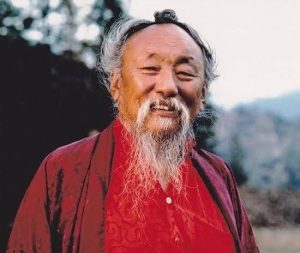 Chagdud Tulku Rinpoche was born in 1930 as Padma Gargyi Wangchuk in the Thromtar region of Kham in Eastern Tibet. His father was Sera Kharto Tulku, a lama of the Gelugpa School of Tibetan Buddhism. His mother was Delog Dawa Drolma, who was widely considered to be an emanation of Tara, and was from a Sakya family; she had a profound influence on her son’s spiritual life.
Chagdud Tulku Rinpoche was born in 1930 as Padma Gargyi Wangchuk in the Thromtar region of Kham in Eastern Tibet. His father was Sera Kharto Tulku, a lama of the Gelugpa School of Tibetan Buddhism. His mother was Delog Dawa Drolma, who was widely considered to be an emanation of Tara, and was from a Sakya family; she had a profound influence on her son’s spiritual life.
By the time he was three years old, Chagdud Tulku Rinpoche had been recognized as the incarnation of the previous Chagdud Tulku. Soon afterward he traveled to Temphel Gonpa, a monastery about two or three days by horseback from Thromtar. After a retreat, he received numerous teachings, empowerments and oral transmissions from a number of spiritual masters. One of them, Shechen Rabjam Rinpoche, told him that Tara meditation would become one of his major practices. Shortly after completing his first three-year retreat in 1945, he went to see Dzongsar Khyentse Chökyi Lodrö. Chagdud Tulku received the Rinchen Terzö empowerments from him, and also met Dilgo Khyentse at that time, who was also attending the empowerments. By 1946 Chagdud Tulku Rinpoche had entered his second three-year retreat, this time under the guidance of the Tromge Trungpa Rinpoche. Near the conclusion of this retreat, the death of Tromge Trungpa forced Chagdud Tulku to leave his retreat before its completion. He returned to Chagdud Gonpa in Nyarong, and after staying there for some time, he proceeded on a pilgrimage to Lhasa with an entourage of monks. This was followed by an extended retreat at Samye, the monastery built by Padmasambhava. Afterwards, he attended empowerments given by Dudjom Jigdral Yeshe Dorje, who would become a main teacher as well as a source of spiritual inspiration. Chagdud Tulku stayed in Lhasa during 1957, in the same house as Khenpo Dorje, whom he regarded as his root lama. Among his other teachers were Shechen Kongtrul, Tulku Arig and Dudjom Jigdral Yeshe Dorje.
Following the Chinese invasion of Tibet in 1959, Chagdud Tulku escaped along with Khenpo Dorje to India after enduring hunger and many dangers—it looked like they would be captured. His route took him through the Pemakö region of Tibet, and his group came out from there into the Indian state of Nagaland. Chagdud Tulku lived in a number of Tibetan refugee resettlement camps in India—Kalimpong, Odisha, Dalhousie, Bir, Himachal Pradesh, and Delhi. He practiced traditional Tibetan medicine, and was in great demand since his fellow refugees had trouble coping with the heat and the tropical diseases found in India. A year or two after his arrival in India, Rinpoche entered a retreat at Tso Pema, Padmasambhava’s sacred lake located near the city of Mandi, Himachal Pradesh. At Tso Pema he met Jangchub Dorje, a primary disciple of Apang Tertön and a lineage holder of this great terton’s Red Tara cycle. Jangchub Dorje gave him the empowerments for the Red Tara cycle, Chagdud Tulku re-entered retreat, and signs of accomplishment in the practices came very swiftly. Later, when he began teaching in the West, the Red Tara sadhana would become the meditation most extensively practiced by his Western students.
After giving a teaching in Kulu Manali, Himachal Pradesh, the 14th Dalai Lama extended an invitation for Rinpoche to go to the United States to teach, contingent upon his getting a visa. It was at this time that Chagdud Tulku moved to Delhi, where he lived in Majnu ka tilla, a Tibetan camp on the banks of the Yamuna River. The process of getting a visa went on for three years, and was ultimately unsuccessful. During this time period Rinpoche met his first Western students, but he also caught malaria and almost died. He was saved by an Indian doctor who finally made the correct diagnosis of what was ailing him.
In the fall of 1977, Dudjom Jigdral Yeshe Dorje gave empowerment cycles in Kathmandu, Nepal, in order to propagate the sacred lineages for a new generation. Chagdud Tulku decided to travel there in order to receive all the empowerments of the Dudjom treasures from Dudjom Rinpoche. Hundreds of tulkus, scholars, yogis and lay practitioners gathered at Dudjom Jigdral Dorje’s monastery, Orgyen Dho Ngag Choling at Tusal, Boudhanath, Kathmandu, Nepal for these empowerments. Rinpoche stayed in Nepal into 1978 in order in order to attend a new series of empowerments in the Chokling Tersar cycle given by Dilgo Khyentse. It was while attending one of these empowerments that a Western woman, Jane Dedman (later Chagdud Khadro) approached Chagdud Rinpoche with the offering of a white scarf and a jar of honey. He invited her to lunch afterwards, and shortly after this he gave her some teachings. A month or so later he accepted her offer to serve as his attendant in retreat after the empowerments. This retreat lasted for several months, after which Dudjom Jigdral Yeshe Dorje suggested among other things that Chagdud Rinpoche travel to America to teach. After many months of waiting, he was finally granted a visa and arrived in San Francisco on October 24, 1979.
In 1992 Chagdud Rinpoche received an invitation to teach in Brazil, where he would become a pioneer in spreading the Dharma in South America. He maintained an extensive teaching schedule throughout the 1990s, put some of his senior students into three-year retreats, and helped to establish many Chagdud Gonpa centers throughout the Western Hemisphere. These include more than thirty-eight Dharma centers under Chagdud Tulku’s supervision and inspiration in the USA, Brazil, Chile, Uruguay, Switzerland and Australia. The best known are Rigzin Ling in Junction City, California, and Khadro Ling, the seat of Chagdud Gonpa Brasil in Tres Coroas, Brazil. While Chagdud Rinpoche maintained a tremendous amount of Dharmic activity, in the last few years of his life he was slowed down somewhat by diabetes. In 1997 he was diagnosed with a serious heart condition. In the last year of his life, Rinpoche’s body began to hinder his outer activities. He tired more easily, and travel became difficult. He cancelled a trip to the United State in 2002, and instead entered into a strict retreat. In the last week of his life, he concluded his retreat on Tuesday, November 12th, 2002, worked with a student artist to complete a statue of Amitabha, talked with many of his students, and led a training in phowa (the transference of consciousness at the moment of death) for more than three hundred people. He continued teaching with great vigor until about 9:00 p.m. on Saturday, November 16. Then on Sunday morning the 17th at about 4:15 a.m. Brazilian daylight time, he suffered heart failure while sitting up in bed. He remained in a state of meditation, with no deterioration of his physical form, for over five days after his last breath. Then he was taken from Brazil to Nepal, where his cremation took place.
2nd President: Lama Sherab Dorje Rinpoche
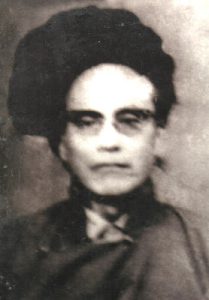 Lama Sherab Dorje Rinpoche aka Rebkong Ngagchang Sherab Dorje was a yogi of Repkong Monastery in Amdo, Tibet. He was one of the main disciples of Dudjom Rinpoche. Lama Sherab Dorje went to India as a Tibetan refugee in the 1960s. At that time, due to the fact that all yogis and ngakpas were having trouble with their dreadlocks adjusting to India’s humidity and sanitation (epidemics of head lice were rampant), Dudjom Rinpoche ordered all of them to keep their hair combed and tied back. Lama Sherab wished to cut his dreadlocks when he arrived in Orissa, but Dudjom Rinpoche instructed Lama Sherab not to cut his hair. In accord with his Guru’s command, Lama Sherab kept his long dreadlocks for the rest of his life.
Lama Sherab Dorje Rinpoche aka Rebkong Ngagchang Sherab Dorje was a yogi of Repkong Monastery in Amdo, Tibet. He was one of the main disciples of Dudjom Rinpoche. Lama Sherab Dorje went to India as a Tibetan refugee in the 1960s. At that time, due to the fact that all yogis and ngakpas were having trouble with their dreadlocks adjusting to India’s humidity and sanitation (epidemics of head lice were rampant), Dudjom Rinpoche ordered all of them to keep their hair combed and tied back. Lama Sherab wished to cut his dreadlocks when he arrived in Orissa, but Dudjom Rinpoche instructed Lama Sherab not to cut his hair. In accord with his Guru’s command, Lama Sherab kept his long dreadlocks for the rest of his life.
Lama Sherab Dorje arrived in Orissa, India, in 1963, when Dudjom Rinpoche was building Dundul Raptenling. Lama Sherab Dorje was invited to Bhutan and instructed by Kyabje Dudjom Rinpoche to do the ground breaking ceremony there for the Thimphu Memorial Stupa. When he returned from Bhutan and Nepal, Lama Sherab Dorje was appointed the second president of the monastery. He spent the rest of his life teaching the dharma to the people of Odisha.
Lama Sherab Dorje was also the uncle of Lama Tarchin Rinpoche (1936-2013), the founder of the Vajrayana Foundation (Pema Osel Ling) in Watsonville, California. Lama Sherab Dorje Rinpoche’s son (who was born in Orissa) is Lopön Jigme Thutop Namgyal, who lives in Marin County, California with his wife and four children.
3rd President: Khenchen Tulku Shekar Rinpoche
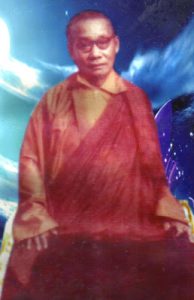 Tulku Shekar Rinpoche, also known as Jamtul Rinpoche, was born in Doetoe Nangchen Taktser Puntsang, Tibet, in 1910. His father was Taksar Kuntentar and his mother was Punsa Karzey Lhamu. He was recognized as the third Jamtul Rinpoche by Palyeon Dhampa Dupwang Tashi Chophel. As a child, Tulku Shekar studied under Lodoey Tenzin. He went to Lhatse Yee Choder at the age of thirteen, where the Ngakpa lama Khenchen Pema Namgyal taught him the Nyingma prayers and rituals. Tulku Shekar became an expert in both the sutras and the tantras, in painting, traditional Tibetan crafts, Tibetan spiritual dancing, etc., and wrote a book on the peaceful Gesar of Ling. He also meditated in the mountains for several years in retreat. After the completion of his retreat, he started travelling to different places to spread the teachings of the dharma. He taught at Kunsang Doenagling as well as Gyaltsab Reting Rinpoche’s monastery called Gomchen Datsang Orgyenling for many years. He came to India as a refugee in 1959, and settled in Odisha at the Dundul Raptenling Monastery. He was elected the third president of the monastery, which he served and helped to develop for one and a half years.
Tulku Shekar Rinpoche, also known as Jamtul Rinpoche, was born in Doetoe Nangchen Taktser Puntsang, Tibet, in 1910. His father was Taksar Kuntentar and his mother was Punsa Karzey Lhamu. He was recognized as the third Jamtul Rinpoche by Palyeon Dhampa Dupwang Tashi Chophel. As a child, Tulku Shekar studied under Lodoey Tenzin. He went to Lhatse Yee Choder at the age of thirteen, where the Ngakpa lama Khenchen Pema Namgyal taught him the Nyingma prayers and rituals. Tulku Shekar became an expert in both the sutras and the tantras, in painting, traditional Tibetan crafts, Tibetan spiritual dancing, etc., and wrote a book on the peaceful Gesar of Ling. He also meditated in the mountains for several years in retreat. After the completion of his retreat, he started travelling to different places to spread the teachings of the dharma. He taught at Kunsang Doenagling as well as Gyaltsab Reting Rinpoche’s monastery called Gomchen Datsang Orgyenling for many years. He came to India as a refugee in 1959, and settled in Odisha at the Dundul Raptenling Monastery. He was elected the third president of the monastery, which he served and helped to develop for one and a half years.
4th President: Lama Dorje Namgyal Rinpoche
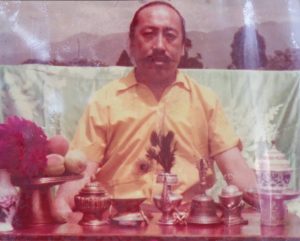 Lama Dorje Namgyal Rinpoche was born at Dorshol Pongyi Ngabhang in Upper Kham, Tibet; his father was named Sonam and his mother was Kyima. Both his parents passed away when Rinpoche was only one year old, and from then on he was taken care of by an older sister. Together they faced many problems during the early years; Rinpoche would console his sister by advising her on karma, showing intelligence and maturity far beyond his young age.
Lama Dorje Namgyal Rinpoche was born at Dorshol Pongyi Ngabhang in Upper Kham, Tibet; his father was named Sonam and his mother was Kyima. Both his parents passed away when Rinpoche was only one year old, and from then on he was taken care of by an older sister. Together they faced many problems during the early years; Rinpoche would console his sister by advising her on karma, showing intelligence and maturity far beyond his young age.
Rinpoche joined the Nyingmapa Drongmo Gon Monastery, where he learned reading and writing, grammar, Buddhist rituals, etc. Later he went into a three-year retreat at that same monastery, where he mastered Dzogchen. After completing his retreat, Lama Dorje Namgyal Rinpoche made a pilgrimage by prostrations to U-lha-den Jowo monastery. This took six months, and he made this effort in order to show his gratitude to his parents.
While on pilgrimage to the six “Mother” Nyingma monasteries of Tibet, Rinpoche met Kyabje Chatral Rinpoche. At their first meeting, Rinpoche had no doubt that Chatral Rinpoche was an accomplished master; he then spent seven years practicing the Longchen Nyingthik preliminary practices as well as Dzogchen with Chatral Rinpoche. He became a very close disciple of Chatral Rinpoche, and was later sent to Kongpo, Tibet, with a letter of introduction from him. Lama Dorje had been advised to perfect his practice of His Holiness Kyabje Jigdral Dorje’s revealed treasures. Lama Dorje Namgyal Rinpoche arrived in Kongpo, where Lama Ling Bhu Chu Rigzin was located; this was the monastery of the second Guru Rinpoche, Kyabje Dudjom Rinpoche. Rinpoche spent three years there, practicing Dzogchen and receiving transmissions and empowerments of the Tersar lineage.
In 1959, Rinpoche left Tibet and arrived in Balapung, Assam, where the first Tibetan refugee center was established. Most Tibetans had great difficulty adapting to the Indian heat and many died. Rinpoche met many of his old Lama Ling spiritual friends there, including Lama Sherab Rinpoche (the second president of Dundul Raptenling). He decided to go to Kyabje Dudjom Rinpoche’s Zangdok Palri Monastery in Kalimpong, India, where he received the Nyingma Kama empowerments and transmissions from His Holiness. When Kyabje Dudjom Rinpoche bestowed the Rinchen Terdzö empowerments at Tso Pema, Rewalser, Rinpoche was the ritual master and fulfilled his duty in front of thousands of devotees.
Once His Holiness the Dalai Lama received permission from the Indian government, a refugee settlement was built in Odisha. Lama Dorje Namgyal Rinpoche, along with Lama Sherab Rinpoche, Chagdud Tulku, Lama Namse Tseso and many other spiritual friends from Lama Ling arrived in Odisha on instruction from Kyabje Dudjom Rinpoche. Each Tibetan refugee was given an acre of land, a small home and a year’s food ration from the Indian government.
All the lamas and rinpoches used to gather in a small house to pray, so Lama Dorje Rinpoche built a clay house as a monastery, which was then named Dundul Raptenling by Kyabje Rinpoche. Lama Dorje Namgyal Rinpoche also served as a teacher at the local school for Tibetans during those difficult years.
Lama Dorje Namgyal Rinpoche served for many years as the president of Dundul Raptenling; he oversaw many activities related to the monastery as well as the lay community. It was during his tenure as president that the three-story Dundul Raptenling Monastery that stands today was built. He made a rule—still observed today—that all funeral rites were conducted at no cost, although the local community was asked to provide the wood for cremations when someone passed away. Lama Dorje Namgyal Rinpoche scheduled yearly prayer ceremonies to benefit all sentient beings. He himself went to perform Chöd at the home of any community member who passed away, and he always consoled the families.
In 1982, he was invited to lend his expertise in the Mendrub Drubchen at the Payul Namdrolling Monastery of Drubwang Penor Rinpoche. Dilgo Khyentse Rinpoche and Penor Rinpoche presided. Lama Dorje Namgyal was requested to perform according to the Kyabje Dudjom Rinpoche ritual. That Mendrub Drubchen was so successful that Rinpoche was named the Mendrub Lama.
Later, Rinpoche was summoned by Trulshik Rinpoche to perform the Eight Heruka empowerment, since he was an expert in this ritual. This was done to aide and help the cause of Tibet in general. This occurred after a divination had been performed by Trulshik Rinpoche at the request of His Holiness the Dalai Lama. Afterwards, Lama Dorje Namgyal Rinpoche went to Shimla at the request of Lama Dawa Chodak. He was requested to subdue the spirits and other elements that were harming students at the Tibetan school. Rinpoche performed Troma Dur for seven days and pacified the area.
In 1985, he opened a retreat center near Dundul Raptenling. The retreat center, which was named Namdrol Choeling by His Holiness Dudjom Rinpoche, was a three-year retreat facility, where the students were taught by Lama Dorje Namgyal Rinpoche. Among Rinpoche’s many students was Dundul Raptenling’s late president, Lama Jamphel Sherab. In 1986, Rinpoche visited his homeland of Tibet. He visited Lhasa, and also travelled to Kongpo, where he bestowed empowerment and taught many devotees and relatives.
Rinpoche sent many young Tibetans from Odisha to join the first shedra established by Kyabje Dudjom Rinpoche in Nepal, known as Shedrup Dujoeling. Among the many students Lama Dorje Namgyal sent to Nepal was the renowned scholar Khenchen Tsewang Rigzin.
Lama Rinpoche spent all of his life serving the dharma; all of his activity was performed in order to benefit sentient beings. His life was such that no one could point out any flaws. Lama Rinpoche passed into parinirvana near the Boudha Stupa in Nepal at the age of sixty-one.
5th President: Kongtul Tsephel Rinpoche
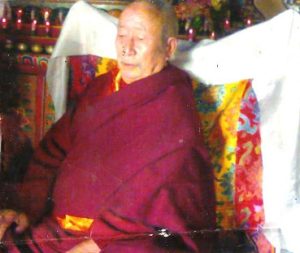 Tulku Tsephel was born in 1926 at Kongpo Bhuchu Dechenten, Tibet, amid numerous wonderful signs. His father was Yab Chöphel and his mother was Mayum Sangye. Tulku Tsephel was recognized as a reincarnation of Tulku Rangbar Rinpoche by the 10th Mindrolling Trirab, Gyurne Dondrup Wangyal. From the age of five, Tulku began to study history and grammar as well as reading and writing with Tulku Jigmey Chöying Norbu at the Rigdzin Gyaling Cave Monastery in lower Kongpo. From the age of fourteen he studied at Mindrolling Monastery, where he completed his studies in the Nyingmapa tradition.
Tulku Tsephel was born in 1926 at Kongpo Bhuchu Dechenten, Tibet, amid numerous wonderful signs. His father was Yab Chöphel and his mother was Mayum Sangye. Tulku Tsephel was recognized as a reincarnation of Tulku Rangbar Rinpoche by the 10th Mindrolling Trirab, Gyurne Dondrup Wangyal. From the age of five, Tulku began to study history and grammar as well as reading and writing with Tulku Jigmey Chöying Norbu at the Rigdzin Gyaling Cave Monastery in lower Kongpo. From the age of fourteen he studied at Mindrolling Monastery, where he completed his studies in the Nyingmapa tradition.
After Tulku Tsephel completed his studies, he returned to Kongpo where, due to the fruition of his previous karma and prayer, his parents first met their root guru, Kyabje Dudjom Rinpoche. They offered their son into the care of His Holiness. Since Tulku Tsephel was a Mindrolling monk, the offer had to be endorsed by Minling Chung Rinpoche, who supported it joyfully, as did Kyabje Dudjom Rinpoche. Tulku served Kyabje Rinpoche for twelve years, travelling with him wherever he went. Thus, he received extensive empowerments, transmissions, and teachings. Tulku completed three Ngöndro sets at the recommendation of Kyabje Rinpoche. During his third Ngöndro, Tulku experienced various signs, after which Kyabje Rinpoche said that the Ngöndro was successful and that it was completed.
Due to the deteriorating political situation in Tibet, Tulku Tsephel was separated from his root guru. But Tulku was reunited with Kyabje Dudjom Rinpoche after Tulku fled Tibet and arrived in India. Once again, he was able to serve Kyabje Rinpoche.
Kyabje Rinpoche asked Tulku Tsephel to go to Odisha and settle there. From that time until he passed away, Tulku stayed in Odisha in order to serve the Dundul Raptenling Monastery. He was appointed the 5th president of the monastery in about 1975. Tulku Tsephel was especially known for his knowledge and accuracy in astronomy and divinations. His prayers and blessings were known as effective and beneficial.
In 1997, Tulku Tsephel hosted and consulted with His Holiness Shenphen Dawa Rinpoche in order to establish the first shedra (monastic educational program) at Dundul Raptenling. The shedra began with twenty-two monks, but eventually most of them left the monastery. At the suggestion of Tulku Tsephel, Lama Sonam Tashi recruited fifteen new monks in 2008.
At about that time, Tulku Tsephel’s health began to fail. Tenshyuk (long-life prayers) were offered by the local Tibetan communities of Kongpo Kyiduk tsokpa, Yephel tsogpa, Pekö tsokpa and the Camp #3 residents, as well as Dundul Raptenling and one of the Namkha Khyung Dzong monasteries located near Dundul Raptenling in Odisha. Tulku regained his health nicely and lived for another three years. During those years, Tulku shared all his thoughts and hopes for the monastery with Lama Sonam Tashi, who had been serving Tulku for a long time. Three months before his passing, Tulku said that he would not be “staying” long. On the fifth day of the Tibetan New Year (March 5, 2010), Tulku passed away, but remained in tukdam (meditative equipoise) for five days. During those five days, there was a very light rain—a very auspicious sign called charpa metok in Tibetan, or rain flower). From the first night of Tulku Tsephel’s passing until his cremation, residents of the area heard the continual chanting voices of dakinis.
Tulku’s cremation was performed on the 10th day of Losar attended by lamas, monks and lay people alike. After the cremation, ringsel (relics) were collected, along with a rainbow-colored bone which can still be seen today. Peköd Tulku Gyalsey Rinpoche suggested prayers for the swift reincarnation of Tulku Tsephel, which Dundul Raptenling Monastery sincerely followed and performed.
6th President: Lama Jamphel Sherap Rinpoche
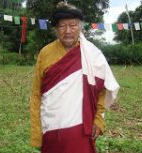 Lama Jamphel Sherap Rinpoche was born in Amdo Janrike, Tibet. His father’s name was Orgyen Tagu and his mother’s name was Dolker Tenzin. His name was given to him by Tulku Jamyang Rinpoche. At the age of seventeen, he went on pilgrimage to different spiritual places in Tibet. Later, in 1947, he went to India and Nepal on pilgrimage. In the village of Garshak, Himachel Pradesh, he met Lama Kunga Rinpoche, who had been a student of Tulku Tokden Shakya Shri. Lama Jamphel Sherap studied with Lama Kunga for two years, and spent those two years doing Tsalung practice. Later he received the Nyingma Gyubum, the Kama, the Rinchen Terdzö and Dudjom Tersar empowerments from His Holiness Dudjom Jigdrel Yeshe Dorje Rinpoche. He went to Odisha Phuntsokling, where he stayed in retreat for three years under the guidance of Lama Dorje Namgyal Rinpoche (the 4th president of Dundul Raptenling) at Pholong Sangay Rinpoche Labrang. He continued to stay in retreat for many years after that doing prayer and meditation. After the passing of Tulku Tsephel Rinpoche (Dundul Raptenling’s 5th president) in 2010, Lama Sonam consulted Khandro Sangyum Rinpoche and Kyabje Shenphen Dawa Rinpoche, and Lama Jamphel Sherap Rinpoche was then appointed the 6th president of Dundul Raptenling. Rinpoche served the monastery from 2011 to 2016. Lama passed away in December, 2018 in Ooty, Tamil Nadu, India.
Lama Jamphel Sherap Rinpoche was born in Amdo Janrike, Tibet. His father’s name was Orgyen Tagu and his mother’s name was Dolker Tenzin. His name was given to him by Tulku Jamyang Rinpoche. At the age of seventeen, he went on pilgrimage to different spiritual places in Tibet. Later, in 1947, he went to India and Nepal on pilgrimage. In the village of Garshak, Himachel Pradesh, he met Lama Kunga Rinpoche, who had been a student of Tulku Tokden Shakya Shri. Lama Jamphel Sherap studied with Lama Kunga for two years, and spent those two years doing Tsalung practice. Later he received the Nyingma Gyubum, the Kama, the Rinchen Terdzö and Dudjom Tersar empowerments from His Holiness Dudjom Jigdrel Yeshe Dorje Rinpoche. He went to Odisha Phuntsokling, where he stayed in retreat for three years under the guidance of Lama Dorje Namgyal Rinpoche (the 4th president of Dundul Raptenling) at Pholong Sangay Rinpoche Labrang. He continued to stay in retreat for many years after that doing prayer and meditation. After the passing of Tulku Tsephel Rinpoche (Dundul Raptenling’s 5th president) in 2010, Lama Sonam consulted Khandro Sangyum Rinpoche and Kyabje Shenphen Dawa Rinpoche, and Lama Jamphel Sherap Rinpoche was then appointed the 6th president of Dundul Raptenling. Rinpoche served the monastery from 2011 to 2016. Lama passed away in December, 2018 in Ooty, Tamil Nadu, India.
7th President: Lama Kelsang Nyima Rinpoche
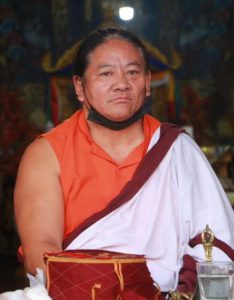 Lama Kelsang Nyima (b.1967) was born on the 15th day of the 6th month of the Tibetan calendar to his father, Khorta Tsetop, and his mother, Paldon at Tsaru, Doetoe, Amdo, Tibet. Lama Nyima did not have an opportunity to study the dharma until 1975, because of the pressures and restrictions of the Chinese regime. After 1976, although there was some freedom to teach, many teachers/gurus understandably hesitated to teach. Lama Kelsang decided to leave Amdo, and went to Ngari, in the Mount Kailish region of Eastern Tibet; he faced many obstacles along the way.
Lama Kelsang Nyima (b.1967) was born on the 15th day of the 6th month of the Tibetan calendar to his father, Khorta Tsetop, and his mother, Paldon at Tsaru, Doetoe, Amdo, Tibet. Lama Nyima did not have an opportunity to study the dharma until 1975, because of the pressures and restrictions of the Chinese regime. After 1976, although there was some freedom to teach, many teachers/gurus understandably hesitated to teach. Lama Kelsang decided to leave Amdo, and went to Ngari, in the Mount Kailish region of Eastern Tibet; he faced many obstacles along the way.
Lama Kelsang’s first teacher in Ngari was Wangthang Tulku, a Drikung Kagyu lineage lama at the Gyandrak Monastery. Lama Kelsang completed his preliminary practices with Wangthang Tulku, who also conferred the Troma Nakmo empowerment; Lama Kelsang Nyima then began the Krodikali practice. Later at Tsurphu, Lama Kelsang Nyima Rinpoche received the Amitabha, Chenrezig and Mitrugpa empowerments and teachings from Lama Karma Dechen. Lama Kelsang circumambulated Mount Kailish one hundred times along with members of his family. He received the Longchen Nyingthik teachings, including the Dzogchen Trikchuk teaching from the great master Golok Togdhen Rinpoche. While he was at Samye accomplishing mantras, Lama Kelsang received the mind instruction and other teachings and blessings from Khenchen Jigmey Phuntsok.
Lama Kelsang arrived in India in 1990, and completed a three-year retreat on the Eight Herukas (which had been conferred by His Holiness the 14th Dalai Lama). His retreat master was Lama Khamtrul Rinpoche. Later he moved to Nepal, where Dungsey Thinley Norbu Rinpoche conferred His Holiness Dudjom Rinpoche’s Richo teaching and mind instruction from the Dudjom Tersar. Lama Kelsang Rinpoche also received the Rinchen Terdzö empowerment from Penor Rinpoche and the transmission from Shechen Rabjam Rinpoche. He received the Rigdzin Düpa empowerment from Chatral Rinpoche. Back in India later, the ngakpa siddhi Golok Lama Pema Tenpo conferred Dzogchen instructions, which Lama Kelsang received again later from Kyanchak Rinpoche. The Troma empowerment, transmission and instruction were conferred by Lama Yeshi Dorje, a disciple of Kyabje Dudjom Jigdral Rinpoche. In Darjeeling, Lama Kelsang received the Dudjom Tersar transmission from Dzongsar Khyentse Rinpoche. In 1997, Lama Kelsang Rinpoche arrived at the Odisha Tibetan settlement, where he received the Rinchen Terdzö empowerment from Namkha Drimed Rabjam Rinpoche. In 2020, he also received the entire transmission of the Jatsön Nyingpo treasure texts from Gyalsey Rinpoche.
After the passing of Tulku Tsephel in 2010, Lama Sonam Tashi consulted with the late Shenphen Dawa Rinpoche about Tulku Tsephel’s successor. Lama Kelsang Rinpoche was then enthroned as the 7th president of Dundul Raptenling Monastery. Serving as the president, Lama Kelsang Rinpoche cares for the monastery by attending and leading all prayers and occasions at the monastery.
Current Administrative Director: Lama Sonam Tashi
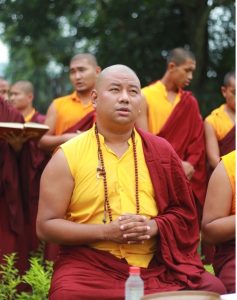 Lama Sonam Tashi as born on November 8, 1987 to father Champon Lama Dorjee Thinley and mother Nyima Youdon at the sacred site of Palden Lhamo, Kolkata, West Bengal, India. His name was bestowed upon hIm by his grandfather, Aumtse Chenpo Dutse Dorjee. Dutse Dorjee was appointed as the Dudjom Tersar’s cham (vajra dance) teacher by His Holiness Kyabje Dudjom Rinpoche. Lama Sonam Tashi’s father, Dorjee Thinley, succeeded his own father as the cham master and umdzé. Six children were born to Dorjee Thinley and Nyima Youdon. One passed away in childhood; Sonam Tashi is the third of the remaining five siblings.
Lama Sonam Tashi as born on November 8, 1987 to father Champon Lama Dorjee Thinley and mother Nyima Youdon at the sacred site of Palden Lhamo, Kolkata, West Bengal, India. His name was bestowed upon hIm by his grandfather, Aumtse Chenpo Dutse Dorjee. Dutse Dorjee was appointed as the Dudjom Tersar’s cham (vajra dance) teacher by His Holiness Kyabje Dudjom Rinpoche. Lama Sonam Tashi’s father, Dorjee Thinley, succeeded his own father as the cham master and umdzé. Six children were born to Dorjee Thinley and Nyima Youdon. One passed away in childhood; Sonam Tashi is the third of the remaining five siblings.
Sonam Tashi went to the Nepal Dudjom Monastery in 1990 to study the Dudjom lineage. He attended the Central School for Tibetan Chandagiri for three years beginning in 1996. He joined Dundul Raptenling Monastery in 1999, where he learned Tibetan grammar, spelling, Lo-zin (Tibetan oral texts) and studied the Nyingma sutras with Namdrolling Khenpo. Along with all the other monks, he received the Dudjom rituals from his master the late Lama Pema Choeying. He completed his ritual studies with Lopön Jamyang after his master Pema Choeying passed away. He also received Gampopa’s dharma treasures from his father, Lama Dorjee Thinley. Sonam Tashi lacked interest in academics and was rather stubborn as a child, yet was very respectful to his teachers and elders, and was kind to the very young. At a young age he showed great determination and interest in serving the dharma, and was liked and trusted by all.
Initial Responsibility:
During the decline of Dundul Raptenling in about 2005, Lama Sonam Tashi started helping the incumbent monastery president, the Venerable Tulku Tsephel by sharing some responsibilities. At first, Lama Sonam struggled to continue with all the monthly offerings and continuing with all the traditional sacred services. At the request of Tulku Tsephel Rinpoche, Lama Sonam toured India to raise funds to resurrect the monastery to its previous glory. With the donations he collected, he was able to assemble about fifteen new monks, and he used the funds to improve the situation of the monastery as well as the lives of the monks. He has taken guidance and suggestions about monastery affairs twice from His Holiness Dudjom Yangzi Pema Zhepa Rinpoche. Lama Sonam Tashi requested financial aid from the Religious and Cultural Department of the Central Tibetan Administration for the education of the monks, and he now receives a monthly lopön’s salary from that department.
When Tulku Tsephel Rinpoche passed away in 2010, the entire responsibility for the monastery fell upon Sonam’s shoulders. He faced many challenges in financial management and planning, as there were no funds to provide for food and other basic expenses. During that time, he contacted high lamas including Kyabje Garab Rinpoche, Kyabje Dzongsar Khyentse Rinpoche and the late Kyabje Shenphen Dawa Rinpoche for help. All three rinpoches agreed to help, and since then the monastery’s finances have stabilized.
In 2016, Lama Sonam Tashi was able to build a new dormitory and classroom building through the generous sponsorship of Dungsey Garab Dorjee Rinpoche. Other donors sponsored the purchase of new lama dancing masks for Guru Tsyengye Cham (the Eight Avatars), and many other lama dancing masks totaling seventy in all, as well as lama dancing costumes. New thrones were made, and many ritual implements and items were also purchased. Many other smaller projects have also been successfully accomplished.
Lama Sonam Tashi continues to teach Buddhists texts and rituals to the monks at Dundul Raptenling. He believes it is due to the blessings of his lamas and teachers, and the prayers and aspirations of his spiritual friends that he has been able to carry out his monastic responsibilities with few obstacles or interruptions. With the blessings of Kyabje Dudjom Yangsi Rinpoche, Lama Sonam began visiting other countries in 2019; this has helped provide the financial resources needed for the construction of the new library at Dundul Raptenling, as well as the ongoing Zangdok Palri construction project.
Empowerments, Initiations and Transmissions:
Lama Sonam Tashi received the first half of the Dudjom Tersar empowerments from Kyabje Terton Namkha Drimed Rabjam Rinpoche. He has now successfully prepared and organized that empowerment at Dundul Raptenling. He received the second half of the empowerment and the complete lung of the Dudjom treasure lineage from the late Tulku Tsephel Rinpoche; he also received the secret Me-Ngag and Dam-Ngag from Tulku Tsephel. He received the oral transmission for Kyabje Jamgon Kongtrul’s Nyungne prayer from Kyabje Chatral Rinpoche. He received the full oral transmission of the Kyabje Jamyang Khyentse Chockyi Lodoe zungbum (collected works) from Kyabje Dzongsar Jamyang Khyentse Rinpoche. He received Troma teachings from Kyabje Pekoe Gyalsey Rinpoche as well as the teachings preceding Dudjom Rinpoche’s Dham-ngag and Phowa. He received the full oral transmission of Kyabje Degyal Rinpoche’s zungbum from Kyabje Tulku Gyepa Dorjee Rinpoche. He received the empowerment of Taksham Terchoe from Kyabje Terchen Namkha Drimed Rabjam Rinpoche. He received the empowerment of the entire Rinchen Terdzö from Kyabje Drupwang Pema Norbu Rinpoche. He received the complete oral transmission of the Rinchen Terdzö from Kyabje Shechen Rabjam Rinpoche. He received the Kalachakra empowerment from His Holiness the Dalai Lama. He received the Grand Troma Empowerment from Kyabje Dungsey Garab Rinpoche. He also learned the Dudjom dharma lineage dances from his father, Champon Lama Dorjee Thinley. He received the Ling Dro (Ling Gesar’s Sacred Dances), and the Lhamo of Druptop Thangtong Gyalpo from the instructors at the Tibetan Institute of Performing Arts in Dharamsala, India. He received the Jatsön Nyingpo empowerment and transmission from Kyabje Pekoe Gyalsey Rinpoche. He has received the Troma empowerment, as well as the Dorje Drolö and Tara empowerments from Kyabje Dudjom Yangsi Rinpoche.
His additional achievements:
Lama Sonam Tashi has published the Dudjom Comprehensive Mandala, which has benefitted practitioners of the Tersar lineage worldwide. He has also written a book on Tibetan handwriting, the Kunphel Yigsu Theb, the Dudjom Solka, as well as a Rime (nonsectarian) daily prayer book. He also created a video CD of the Dudjom Tersar tradition of cham, or lama dancing. The CD was appreciated by Dudjom Rinpoche and Dungsey Garab Rinpoche, both of whom provided support for this project. Lama Sonam has organized the rare and sacred Kilaya Mendrup Drupchen three times at Dundul Raptenling, each led by high lamas at the monastery. He is also currently overseeing the newly formed Troma Tsogpa, a group of lay practitioners at Odisha. He teaches and leads them in a monthly Chöd gathering,
Lama Sonam Tashi’s gratifying accomplishment:
During February and March of 2016, Lama Sonam Tashi was able to host the visits of two dungseys, Kyabje Garab Dorjee Rinpoche and Kyabje Kathok Situ Rinpoche. During those visits, both rinpoches conferred many empowerments and gave heartfelt spiritual counsel and advise to the monks and general public as well. All these events occurred without obstacles or impediments of any kind, leaving all the participants blessed and in awe. At that time, Lama Sonam also held the grand enthronement ceremony of his karmic guide and root guru, the Yangsi of the venerable Tulku Tsephel Rinpoche. The ceremony was conducted by Kyabje Kathok Situ Rinpoche, following the Yangsi’s recognition and authentication by the late Dudjom Sangyum Khandro Rigzin Wangpo Rinpoche as well as the late Kyabje Shenphen Dawa Rinpoche.
In 2017, Lama Sonam Tashi was the chanting master at the Second Troma Bhumtsok puja led by His Holiness Dudjom Yangsi Rinpoche in Nepal, where the Million Tsok Puja was offered for world peace. At that time, Lama Sonam Tashi also chanted Bhumtsok for several days in the Sherpa Monastery of Kathmandu. He chanted in front of thousands of rinpoches, lamas, monks, nuns, and the public. Lama has taught over one hundred Troma practitioners in South India in Bylakuppe, over one hundred Troma practitioners in North India in Uttarkhand, and over fifty Troma practitioners in Odisha. Lama Sonam Tashi is very pleased that many people are joining the Troma practice. In 2020 Lama Sonam Tashi organized the Jatsön Nyingpo empowerment in Odisha led by Kyabje Pekoe Gyalsey Rinpoche and Kyabje Dakpo Rinpoche. Thousands of people attended.
With the wonderful help of his students in Singapore, Lama Sonam has completed a new class room, an additional dormitory, a computer room, a library, an office and a large teaching hall measuring 170 feet long. This was all completed early in 2020. During the COVID-19 lockdown period, Lama Sonam Tashi provided rations and food staples for almost 1,000 Indian and Tibetan households. He was also able to provide PPE kits to all the doctors and nurses in his area, as well as to provide 3,000 masks for the population of the Tibetan settlements.